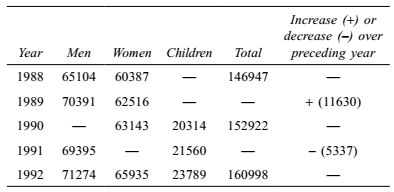Table chart
Direction: Following Table gives the population of a locality from 1988 to 1992. Read the Table and answer the questions.

- The number of women in 1991 is:
-
View Hint View Answer Discuss in Forum
∵ The number of women in 1991 = Total population in 1991 − ( Total number of children in 1991 + Total number of men in 1991 )
Correct Option: A
Given :- Total population in 1990 = 153922 , increase = 5337
Total population in 1991 = Total population in 1990 - increase in 1991 = 153922 - 5337 = 148585
Total number of children in 1991 = 21560
Total number of men in 1991 = 69395
∴ The number of women in 1991 = Total population in 1991 − ( Total number of children in 1991 + Total number of men in 1991 )
= 148585 − ( 21560 + 69395 ) = 57630.
- The number of children in 1988 is:
-
View Hint View Answer Discuss in Forum
The number of children in 1988 = Total population in 1988 − ( Total number of men in 1988 + Total number of women in 1988 )
Correct Option: D
From above given table , we have
Total population in 1988 = 146947
Total number of men = 65104
Total number of women = 60387
The number of children in 1988 = Total population in 1988 − ( Total number of men in 1988 + Total number of women in 1988 )
= 146947 − (65104 + 60387) = 21456.
- The number of children in 1989 is:
-
View Hint View Answer Discuss in Forum
∵ The number of children in 1989 = Total population in 1989 − ( Total number of men in 1989 + Total number of women in 1989 )
Correct Option: A
Given :- Total population in 1988 = 146947 , increase = 11630
Total population in 1989 = Total population in 1988 + increase = 146947 + 11630 = 158577
∴ The number of children in 1989 = Total population in 1989 − ( Total number of men in 1989 + Total number of women in 1989 )
= 158577 − (70391 + 62516) = 25670.
Direction: Figures of biscuit exports from a country during various years are given in the following table. Study the table carefully and answer the questions that follows:

- During which years price per tin remained at the same level?
-
View Hint View Answer Discuss in Forum
Export price per tin in 2004 = Price in 2004/ Quantity in 2004
Export price per tin in 2005 = Price in 2005 / Quantity in 2005
Export price per tin in 2006 = Price in 2006 / Quantity in 2006
Export price per tin in 2007 = Price in 2007/ Quantity in 2007
Export price per tin in 2008 = Price in 2008/ Quantity in 2008Correct Option: C
Export price per tin in 2004 = Price in 2004/ Quantity in 2004
Export price per tin in 2004 = 150 crores/ 100 lakhs = Rs. 150
Export price per tin in 2005 = Price in 2005 / Quantity in 2005
Export price per tin in 2005 = Rs. 150 crores/Rs. 75 lakhs = Rs. 200
Export price per tin in 2006 = Price in 2006 / Quantity in 2006
Export price per tin in 2006 = Rs. 330 crores/Rs. 150 lakhs = Rs. 220
Export price per tin in 2007 = Price in 2007/ Quantity in 2007
Export price per tin in 2007 = Rs. 400 crores/Rs. 160 lakhs = Rs. 250
Export price per tin in 2008 = Price in 2008/ Quantity in 2008
Export price per tin in 2008 = Rs. 500 crores/Rs. 200 lakhs = Rs. 250
it is clear that per tin export price was same in 2007 and 2008.
Direction: Study the table carefully to answer the questions that follow:

- If to pass in the examination the minimum marks rewired in Maths are 95 and in Social studies are 85, how many students will pass ?
-
View Hint View Answer Discuss in Forum
Pass percentage in Maths = Minimum passing marks in Maths x 100/total maths marks for math
Pass percentage in Social studies = Minimum passing marks in Social studies x 100/total maths marks for Social studiesCorrect Option: E
Pass percentage in Maths = Minimum passing marks in Maths x 100/total maths marks for math
Pass percentage in Maths = 95 x 100/150 = 63.3%
Pass percentage in Social studies = Minimum passing marks in Social studies x 100/total maths marks for Social studies
Pass percentage in Social studies = 85 x 100/125 = 68%
It is cleans from the table that Ravi and and Kirti will pass in the examination.

